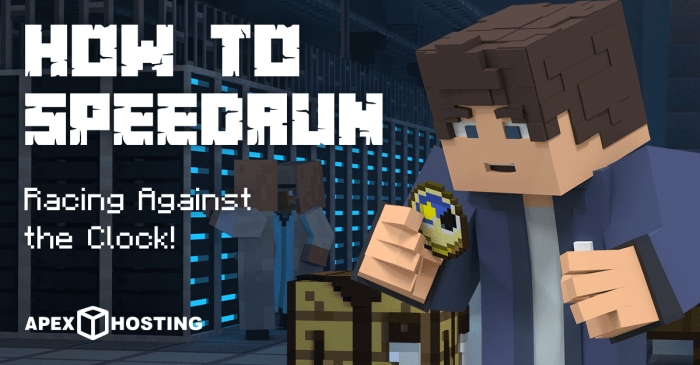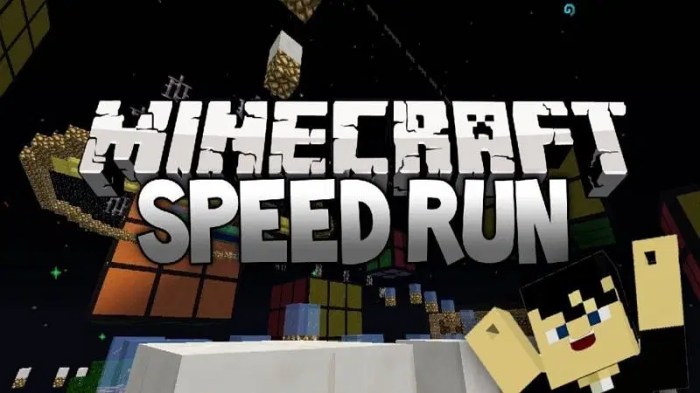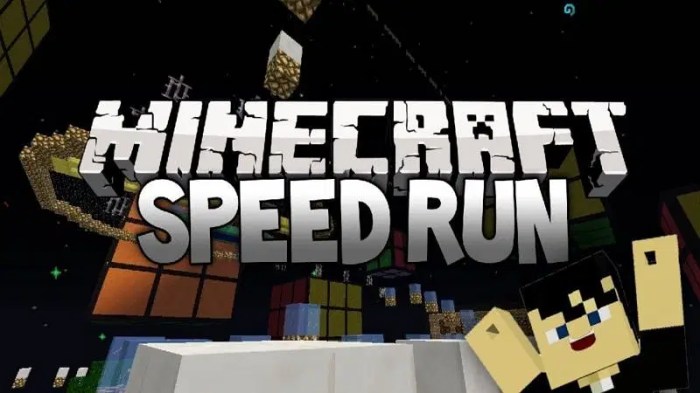Speedruns, at their core, are all about pushing the boundaries of video games. It’s not just about finishing a game; it’s about mastering every mechanic, exploiting every glitch, and shaving off every precious second to achieve the ultimate victory. This exploration dives into the history, techniques, community, and impact of this exhilarating subculture.
From the early days of rudimentary timer-based attempts to today’s highly organized, globally-streamed competitions, speedrunning has evolved into a vibrant community with its own unique set of rules, strategies, and even rivalries. We’ll cover the various categories, from “Any%” runs where players aim for the fastest possible completion to the meticulous “100%” runs that demand absolute mastery. We’ll also explore the incredible tools and techniques used to achieve these superhuman feats, from advanced route planning to exploiting hidden game mechanics.
Definition and History of Speedruns

Speedrunning, at its core, is the act of completing a video game as quickly as possible. It’s more than just rushing through; it involves meticulous planning, precise execution, and often, the exploitation of glitches and in-game mechanics to shave off precious seconds. The community surrounding speedrunning is incredibly diverse, encompassing a wide range of skill levels and approaches, from casual players aiming for personal bests to highly competitive individuals vying for world records.Speedrunning categories provide structure to this competitive pursuit.
These categories define the specific rules and limitations under which a game is played. For example, a “Any%” category allows players to complete the game using any means necessary, often skipping large portions of content. Conversely, a “100%” category requires completing every objective within the game, leading to significantly longer run times. Other categories might focus on specific aspects, such as using only certain weapons or completing the game blindfolded.
The variety is immense, offering a challenge for every skill level and preference.
The Evolution of Speedrunning
Speedrunning’s roots are deeply entwined with the early days of gaming itself. While pinpointing the exact origin is difficult, the concept of trying to beat a game as fast as possible has existed almost as long as video games themselves. Early examples often involved informal competitions among friends, documented through rudimentary recordings or word-of-mouth. The advent of the internet, and particularly video-sharing platforms like YouTube, dramatically transformed the speedrunning landscape.
The ability to share and compare runs globally fostered competition and collaboration, leading to a massive increase in participation and the emergence of a vibrant online community.
Early Speedruns and Their Impact
Early speedruns, often captured on low-quality VHS tapes or grainy digital recordings, lacked the polished production values of today’s runs. However, these early attempts laid the foundation for the sophisticated techniques and strategies employed by modern speedrunners. For example, early runs of classic titles likeSuper Mario Bros.* on the NES showcased the potential for exploiting glitches to bypass entire levels, a technique that has become a cornerstone of many speedrunning categories.
These early demonstrations, even in their rudimentary form, captivated audiences and helped establish speedrunning as a distinct and engaging form of gaming. The shared experience of watching someone master a game, often in unexpected ways, created a sense of community and fueled further exploration of game mechanics.
A Timeline of Significant Milestones
A comprehensive timeline would be extensive, but some key milestones include:
- Early 1990s: Informal speedrunning competitions begin amongst friends, often documented poorly or not at all.
- Late 1990s – Early 2000s: The rise of the internet and video-sharing platforms allows for the widespread dissemination of speedruns and the formation of online communities.
- Mid-2000s: Speedrunning communities establish organized events and leaderboards, fostering competition and collaboration.
- Late 2000s – Present: Speedrunning gains mainstream recognition, with dedicated websites, streaming platforms, and even large-scale events like GDQ (Games Done Quick) showcasing the skill and dedication of speedrunners worldwide.
Types of Speedruns

Speedrunning, at its core, is about completing a video game as quickly as possible. However, the “as quickly as possible” part gets a lot more nuanced depending on the chosen category. Different categories impose different rules and restrictions, leading to vastly different strategies and required skill sets. This results in a diverse and fascinating landscape within the speedrunning community.Speedrunning categories are essentially self-imposed challenges that add layers of complexity and competition.
They range from relatively straightforward runs focused solely on speed to incredibly intricate runs requiring deep game knowledge and exploitation of glitches. Understanding these categories is crucial to appreciating the breadth and depth of speedrunning as a competitive activity.
Any% Speedruns
Any% speedruns focus solely on reaching the game’s ending credits as quickly as possible, regardless of the in-game progress or completion percentage. This typically involves skipping large portions of the game, exploiting glitches, and focusing on the most efficient path to victory. Strategies often involve precise movement, memorization of optimal routes, and leveraging unintended game mechanics. The skill set required emphasizes reaction time, precise execution, and strategic thinking to navigate complex routes and exploit glitches effectively.
For example, in a game like
Super Mario 64*, an Any% run might involve using specific glitches to warp across the map, completely bypassing levels and collecting minimal stars.
100% Speedruns
In stark contrast to Any%, 100% speedruns demand completing every aspect of the game. This means collecting all items, completing all side quests, and achieving 100% game completion before reaching the ending. These runs require extensive knowledge of the game world, meticulous planning, and often a different approach to route optimization. Instead of focusing solely on speed, the strategy involves finding efficient ways to collect all necessary items while minimizing wasted time.
The skill set emphasizes patience, thoroughness, and a deep understanding of the game’s mechanics and hidden content. A 100% run of
The Legend of Zelda
Ocarina of Time*, for instance, would require finding every heart piece, every bottle, and completing every dungeon and side quest.
Glitchless Speedruns
Glitchless speedruns adhere strictly to the intended game design, prohibiting the use of any glitches or exploits. This makes these runs the purest form of speedrunning, relying entirely on skillful gameplay and route optimization within the game’s intended boundaries. Strategies are typically focused on mastering movement techniques, understanding enemy AI, and optimizing routes to minimize traversal time. The skill set heavily emphasizes precise gameplay, quick reflexes, and an in-depth understanding of level design and enemy patterns.
A glitchless run of
Mega Man 2*, for example, would require precise timing and skillful use of Mega Man’s abilities to navigate each stage efficiently without resorting to any glitches.
Low% Speedruns
Low% speedruns represent a middle ground between Any% and 100%. They require completing the game while collecting a specific, usually small, number of in-game items or completing only a subset of objectives. The specific requirements vary depending on the game and the community’s established categories. Strategies here often involve a blend of Any% techniques, such as skipping sections, and strategic item collection to meet the minimum requirements.
The skill set combines aspects of both Any% and 100% speedrunning, demanding a balanced approach to speed and item collection. A Low% run of
Metroid Prime* might involve completing the game with only a minimal number of upgrades, requiring strategic decisions about which upgrades to prioritize for efficiency.
| Category | Goal | Common Strategies | Required Skill Set |
|---|---|---|---|
| Any% | Reach the ending credits as fast as possible. | Glitch exploitation, route optimization, skipping content. | Reaction time, precise execution, strategic thinking. |
| 100% | Complete all aspects of the game (100% completion). | Meticulous planning, efficient item collection, deep game knowledge. | Patience, thoroughness, understanding of hidden content. |
| Glitchless | Complete the game without using glitches or exploits. | Mastering movement techniques, route optimization, enemy AI manipulation. | Precise gameplay, quick reflexes, deep understanding of level design. |
| Low% | Complete the game with a minimum number of items/objectives. | Strategic item collection, route optimization, selective content completion. | Balanced approach to speed and item collection. |
The Speedrunning Community

The speedrunning community is a vibrant and surprisingly large global network of players, organizers, and spectators united by a shared passion for pushing the limits of video games. It’s a community built on competition, collaboration, and a deep appreciation for the intricacies of game design, fostering a unique blend of intense rivalry and supportive camaraderie. This intricate web of connections has led to the creation of some of the most memorable moments in gaming history.The culture is characterized by a strong emphasis on self-improvement and pushing personal boundaries.
Runners constantly strive to refine their techniques, optimize strategies, and shave milliseconds off their times. This dedication to improvement is complemented by a strong sense of community, where runners regularly share knowledge, strategies, and support each other. While competition is fierce, there’s a generally positive and helpful atmosphere, especially within specific game communities. The sheer amount of documentation, guides, and resources created by runners is a testament to this collaborative spirit.
Key Figures and Influential Communities
Several individuals and groups have played pivotal roles in shaping the speedrunning landscape. For example, Darbian, known for his incredible skill in various games, including
- Super Mario 64*, and his engaging commentary, has become a highly influential figure, inspiring many aspiring runners. Similarly, the community surrounding
- Ocarina of Time* speedruns is renowned for its depth of knowledge, meticulous route development, and strong collaborative spirit. Communities centered around specific games often develop unique cultures and methods, resulting in distinct styles of play and competition. For instance, the
- Celeste* community is well-known for its emphasis on both speed and skill expression, blending technical prowess with artistic flair. These individual runners and dedicated game communities collectively contribute to the ever-evolving landscape of speedrunning.
Successful Collaborations and Rivalries, Speedruns
The speedrunning world showcases a dynamic interplay between collaboration and competition. Successful collaborations often involve runners specializing in different aspects of a game combining their skills to achieve unprecedented times. A prime example is the coordination required in many co-op speedruns, where precise timing and communication are crucial for success. On the other hand, intense rivalries can fuel innovation and push the boundaries of what’s possible.
The long-standing competition between top runners in games likeSuper Metroid* has resulted in a constant arms race of strategy refinement and record-breaking performances. These rivalries, often marked by mutual respect despite the competitive spirit, contribute significantly to the excitement and continuous improvement within the speedrunning scene.
Popular Speedrunning Events and Their Significance
Major speedrunning events play a crucial role in bringing the community together and showcasing the best talent. Games Done Quick (GDQ), both Awesome Games Done Quick (AGDQ) and Summer Games Done Quick (SGDQ), are perhaps the most well-known, raising millions of dollars for charity while showcasing a diverse range of speedruns. These events highlight the skill and dedication of runners while also fostering a sense of community and shared purpose.
Other notable events, such as various smaller, community-organized marathons, contribute to the overall growth and visibility of speedrunning as a spectator sport. These events serve not only as competitions but also as significant fundraising opportunities and platforms for community engagement.
Clarifying Questions: Speedruns
What’s the difference between Any% and 100% speedruns?
Any% focuses on the fastest completion time, regardless of collected items or completed side quests. 100% requires collecting everything and completing every objective in the game.
How are speedruns verified?
Speedruns are typically verified through dedicated websites like Speedrun.com, which require video evidence and sometimes additional proof of legitimacy.
Can anyone become a speedrunner?
Absolutely! While some games require advanced skills, anyone can start speedrunning. Begin with games you know well and gradually increase difficulty.
What are some popular speedrunning events?
Games Done Quick (GDQ) and Awesome Games Done Quick (AGDQ) are two of the most well-known charity speedrunning events.
